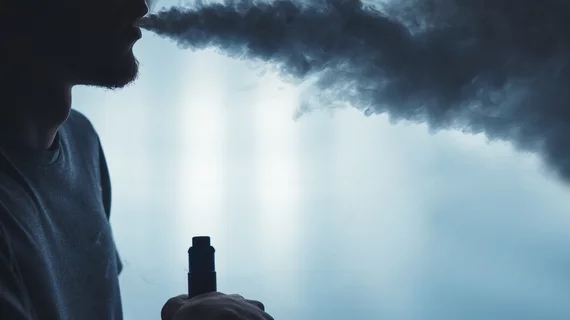Radiologists must play central role in clearing EVALI confusion, experts argue
Scientists are still uncertain about the exact cause of the outbreak of death and disease stemming from vaping products. However, radiologists will play a central role in closing any knowledge gaps.
Those are some of the key takeaways from a new review article, published Tuesday, Jan. 28, in the journal Radiology. Chest imaging can provide important clues about a patient’s condition, and radiologists must intervene to ensure that individuals don’t cause further damage to their lungs. Deaths from e-cigarette or vaping product use-associated lung injury have already climbed to 60 across the U.S., but lives can be saved with early diagnosis.
“Rapid clinical and/or radiologic recognition of EVALI allows clinicians to treat patients expeditiously and provide supportive care,” lead author Seth Kligerman, MD, chief of cardiothoracic imaging and a professor of radiology at UC San Diego Health, said in a statement. “If EVALI is not diagnosed in a timely manner, patients may continue vaping after leaving the doctor’s office, clinic or emergency department which could lead to worsening lung injury,” he added.
Kligerman and colleagues noted that, despite any ambiguities, clinicians are certain that most patients who develop the disease are young adult and adolescent men, with 80% reporting use of THC- or CBD-containing compounds. Patients commonly present with respiratory and gastrointestinal symptoms, along with fever and fatigue. And chest CT scans typically show a pattern of diffuse lung injury with sparing of the periphery of the lungs, the team noted. As a “diagnosis of exclusion,” those with EVALI must have a history of vaping over the previous three months, alongside such abnormalities in chest imaging.
Radiologists need to communicate directly with treating physicians, if they suspect EVALI, to ensure that they consider it as a possible diagnosis, the team urged. Complications from EVALI that radiologists must be aware of include organizing pneumonia and diffuse alveolar damage, along with superimposed infection, bullae formation and pneumothorax. Beyond that, however, it’s too early for clinicians to connect vaping to lung cancer or other pulmonary diseases.
“Right now, we do not know the long-term effects of vaping, as it is still a relatively new method of nicotine and THC delivery, and there are countless variables involved which further confound our understanding of what is happening on a patient-specific level,” Kligerman said. “Although I am hesitant to speculate on specifics as we just do not have the data, I would not be surprised if vaping is directly linked to many of the chronic pulmonary and cardiovascular diseases commonly associated with traditional cigarette smoking,” he added later.

